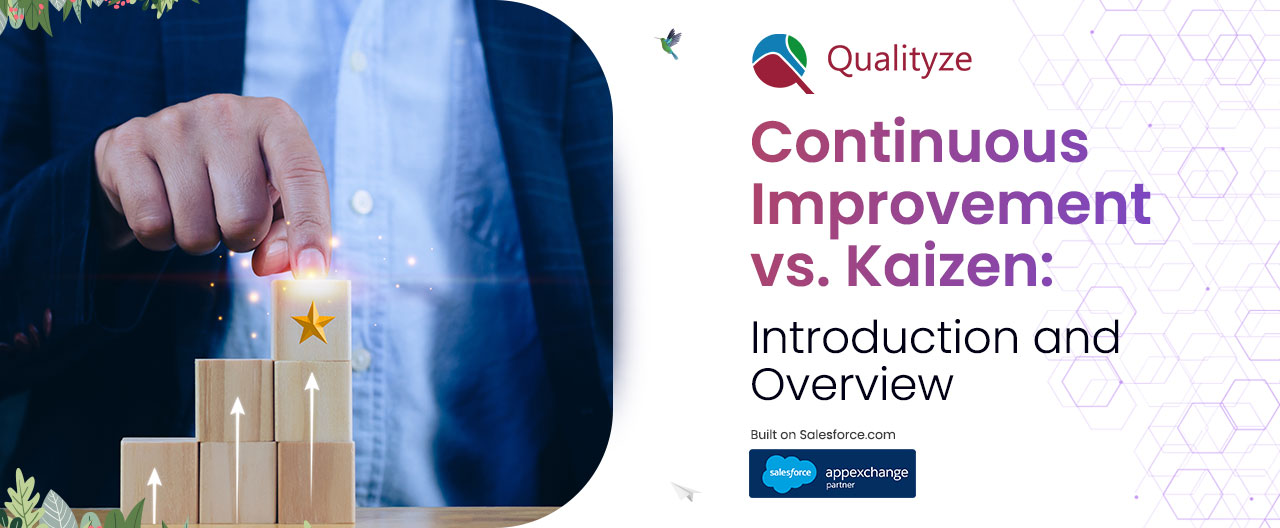Calculate your potential savings with our ROI Calculator
ROI CalculatorCalculate your potential savings with our ROI Calculator
ROI Calculator1 So, what is Continuous Improvement?
2 Examples of Continuous Improvement in Action
3 Key Characteristics of Continuous Improvement
4 Benefits of Continuous Improvement
5 What is Kaizen?
6 Key Characteristics of Kaizen
7 Benefits of Kaizen for Businesses and Organizations
8 Examples of Kaizen in Action
9 Key Differences Between Continuous Improvement and Kaizen
In conclusion

What can you do to improve your business or organization? Do you want to increase efficiency, reduce waste, and enhance productivity? If so, you’ve probably heard of the terms “continuous improvement” and “Kaizen”. These concepts have been widely adopted by businesses worldwide to drive operational excellence, achieve growth, and stay competitive in today’s fast-paced economy.
While continuous improvement and Kaizen share many similarities, they are different. Understanding the key differences between these two approaches is crucial for any organization that wants to succeed in the long run. In this blog post, we’ll explore the definitions, characteristics, and benefits of continuous improvement and Kaizen and highlight their main differences. So now is the time to step up your business!
At its core, continuous improvement is a never-ending process of incremental change. It involves constantly looking for ways to improve processes, products, and services to better meet the needs of customers and stakeholders. The approach is based on the principle that small, ongoing improvements can have a significant impact over time, leading to increased efficiency, reduced waste, and greater customer satisfaction.
Related Article: The Importance of the PDCA Cycle in Driving Continuous Improvement in Organizations
Continuous improvement can be applied to any area of a business or organization. Listed below are just a few examples of how continuous improvement has been applied in different industries:
Continuous improvement is characterized by several key features that set it apart from other improvement methodologies. These include:
Continuous improvement offers many benefits for businesses and organizations, including:
Kaizen is a process-oriented approach to continuous improvement. It involves making small, incremental changes to processes, systems, and workflows over time, to create a culture of continuous improvement. The Kaizen approach is designed to empower employees at all levels of an organization to identify and make changes that improve the quality of their work and the efficiency of their processes.
Kaizen has been used by many companies and organizations worldwide to drive continuous improvement. For example, Toyota has used Kaizen to improve its production processes and reduce waste, while Amazon has used Kaizen to improve its order fulfillment processes and reduce delivery times.
| Key Differences | Continuous Improvement | Kaizen |
| Definition | A methodical approach to identifying and improving processes, systems, and workflows over time. | A philosophy that emphasizes the importance of making small, incremental changes to processes and workflows on an ongoing basis. |
| Focus | On improving processes, systems, and workflows to achieve specific goals. | On creating a culture of continuous improvement by empowering employees to identify and make changes. |
| Methodology | Often involves the use of specific methodologies such as Lean, Six Sigma, and Total Quality Management. | Emphasizes a process-oriented approach to continuous improvement that is designed to empower employees at all levels of an organization. |
| Scope | Can be applied to any process, system, or workflow within a business or organization. | Emphasizes the importance of improving all aspects of a business or organization, from processes and systems to culture and mindset. |
| Benefits | Improved efficiency, reduced costs, and increased customer satisfaction. | Improved employee engagement, increased innovation, and a culture of continuous improvement. |
| Examples | Lean Manufacturing, Six Sigma, Total Quality Management | Toyota Production System, Gemba Kaizen, Kaizen Blitz |
Understanding the differences between continuous improvement and Kaizen is essential for businesses and organizations that want to improve their processes and workflows. While both approaches focus on continuous improvement, their methodology, scope, and benefits differ.
Continuous improvement involves systematically identifying and improving processes, systems, and workflows to achieve specific goals. It often uses specific methodologies such as Lean, Six Sigma, and Total Quality Management. On the other hand, Kaizen emphasizes a process-oriented approach to continuous improvement designed to encourage employees at all levels of an organization. It seeks to improve all aspects of a business or organization, from processes and systems to culture and mindset.
Implementing the approach that best fits your needs and goals is key to success. If you have specific goals and need to improve a particular process, Continuous improvement may be your approach. Creating a culture of continuous improvement that empowers your employees to identify and make changes, Kaizen, maybe the way to go.
In today’s competitive business landscape, continuous improvement is crucial for success. By understanding the differences between Continuous Improvement and Kaizen, businesses and organizations can choose the approach that best fits their needs and goals. Remember, no matter which approaches you choose, the key is to make small, incremental improvements over time to achieve long-term success.
Whether you choose Continuous Improvement or Kaizen, Qualityze EQMS Software Solution can help you achieve your quality goals. So why not give it a try and see the difference it can make for your business or organization? Contact Qualityze today to learn more. You can contact customer success team by email at info@qualityze.com or by phone at 1-877-207-8616, and we will be there at the earliest.